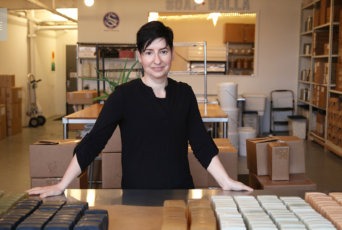When Phoebe Lapine was diagnosed with debilitating Hashimoto’s right after college, it totally transformed her life. After being told that she’d be on medication for the rest of her life, she pursued the “rabbithole” of holistic wellness — but this approach didn’t sit well with her either. And when she finally found a healing path that worked for her (which involved honing in on the link between Hashimoto’s and gluten), she was suddenly presented with a new challenge: small intestinal bacterial overgrowth (SIBO). Read on to hear Lapine’s inspiring health journey, her insights on SIBO symptoms and treatment, and more.
*This is a short clip from Phoebe Lapine’s interview. Click here to watch the whole thing!*
You can also listen to an audio version of our interview with Phoebe Lapine on The WellBe Podcast.
Getting Diagnosed with Hashimoto’s Thyroiditis
Today, Phoebe Lapine is food and health writer, gluten-free chef, author of three books (SIBO Made Simple, The Wellness Project, and 2024 cookbook Carbivore), and host of the SIBO Made Simple Podcast. But the road she took to get to his point was by no means linear.
At age 22, Lapine went to her doctor for a regular check-up, and was completely surprised to leave the appointment with a diagnosis of Hashimoto’s thyroiditis. She had no idea how to feel: she didn’t know what an autoimmune disease was, didn’t even really know what a thyroid was. Compounding the issue was the fact that the doctor didn’t explain any of it to her. What the doctor did tell her was that she could manage the condition, but only if she took the medication synthroid for the rest of her life.
Lapine’s upbringing had leaned toward the holistic, with a household that she describes as “organically minded” and a mother who practiced homeopathy. Though she trusted the doctor’s expertise, the notion that she’d take synthroid forever didn’t sit right with the values instilled in her since childhood. A voice in the back of her mind piped up and said, “Being on medication the rest of my life? No thanks.”
Still, Lapine didn’t think about it too much. This was partly because she didn’t really know what to think about it all, and partly because she wasn’t really noticing any Hashimoto’s symptoms. In fact, one of the main symptoms of Hashimoto’s is weight gain, and she was actually losing weight. And so, she says, “I pretended it never happened and went on living my life as a 22-year-old.”
Then, the condition caught up with her. She began experiencing a wide array of symptoms, most notably digestive issues. Suddenly, eating became a debilitatingly painful experience. After basically every meal or snack, Lapine would find herself lying in the fetal position. At the time, she was trying to make it as a chef and food writer, and so this symptom was particularly inconvenient and upsetting.
Lapine assumed that the digestive issues meant she was allergic to something she was eating, but she didn’t want to be a chef or food writer with a food allergy, and so she swept it under the rug. Again, it seemed that not dealing with it was the easiest choice.
Going Down the Holistic Health Rabbithole
Eventually, her symptoms got bad enough that ignoring them was no longer an option. At that point, Lapine had begun to listen to the voice in the back of her mind from before, the one that pulled her toward her holistic-leaning childhood. So she made her way to the doctor again, but this time, she sought out a functional doctor who took a different approach.
From there, a whole world of holistic treatment approaches opened up — and not necessarily in a good way. “Once I crossed the threshold and went down the rabbithole of exploring holistic medicine, I found myself incredibly overwhelmed by all the conflicting opinions and the laundry list of things I had to do,” remembers Lapine. There was so much information out there, and it was hard to tell which pieces of advice were valid, which ones applied to her, and which ones would make a difference. Lapine was spending so much money and mental energy on her health that it began to feel like it was a full-time job just to stay well.
Lapine knew that this way of life was not sustainable, and so she took a step back. She decided to dedicate one year of her life to slowly making over her health one change at a time, clearing out all the chatter and conflicting advice and replacing it with a simple, reflective approach. She’d make twelve changes, one per month, and pay close attention to how each impacted her health. The goal of this year-long project wasn’t even to be her healthiest self — though of course she wanted that outcome — the goal was simply to answer a question that had been plaguing her: what pieces of health advice were actually worth her time, money, and energy?
Focusing on the Link Between Hashimoto’s and Gluten
Lapine’s year of making slow, methodical lifestyle changes resulted in her book, The Wellness Project. It also led to her making some changes that had a major impact on her health, both in terms of her Hashimoto’s and in terms of the mental overwhelm she felt from all the conflicting advice.
One of the main things she did was hone in on the connection between Hashimoto’s and gluten, and fully remove gluten from her life. When she’d met with the functional doctor a year prior, the first course of action he prescribed was actually doing an elimination diet, which helped him determine that gluten was a major issue for her.
Though the doctor didn’t explain the connection to Lapine at the time, she later learned that there’s a strong link between Hashimoto’s and gluten sensitivity. This has to do with the fact that the gluten protein and the thyroid protein look really similar — and the antibodies sent out to attack the thyroid protein can’t tell the difference, so they attack both. This, in turn, leads to a pretty unpleasant inflammation response. After learning these nuances about Hashimoto’s and gluten, she returned to the doctor’s advice and stopped eating gluten. Like magic, her digestive distress went away.
Another impactful change she made was reducing her toxic load, which she knew was creating additional stress for her body to deal with on a daily basis. A big part of this task was switching all her beauty products to natural ones. She describes this as one of the easiest changes for her, as all it took was a one-time switch and an upfront financial investment, and she never bought conventional products again.
She also got fluoride and chlorine out of her drinking water, since those specific chemicals can be problematic to thyroid health (this is because they complicate how iodine is processed, which complicates the ability of the thyroid gland to function at all). Just as with her beauty products, this was an easy change to make, since she just needed to put a water filter on her tap, and then never thought about it again. These changes might seem small, but Lapine knows they were very impactful in terms of helping her reboot her health (Reducing your toxic burden and swapping conventional products for clean ones is the goal of the WellBe Spark Health Program, which you can sign up for right now!).
At the end of the year, Lapine felt much better than she had at the beginning, but she knows that wellness is an ongoing journey. “I’m still a work in progress,” she says. “My health is going to ebb and flow.” For instance, she’ll get great blood work results, and then a bout of food poisoning will send her back to square one. But at this point, she has all the tools in her toolkit from her year of learning, so she just reaches back in there, takes what she needs, and gets things back on track.
A New Challenge: Navigating SIBO Symptoms and Treatment
Nine months into Lapine’s book tour for The Wellness Project, she began to experience a lot of gastrointestinal problems — even after her new gluten-free diet had alleviated these issues. It was an exciting but stressful time, both mentally and physically, and so Lapine assumed that all the travel and stress was the source of the problem. But then, after the book tour ended, the symptoms didn’t go away. She felt bloated all the time, and would burp like crazy after every meal. She knew she didn’t want to let this become her new normal, and so she went back to her functional medicine doctor for a full workup. That’s when she was diagnosed with SIBO: small intestinal bacterial overgrowth.
The funny thing was that Lapine had written a whole chapter in her book about gut health, eating for her microbiome, taking probiotics, and what actually works in this department — but she was looking at a totally different part of the gut microbiome. SIBO was a whole different story.
As Lapine dug into the world of SIBO symptoms and treatment, she soon learned that when people talk about the benefits of good bacteria in your gut microbiome, they’re mostly talking about the large intestines — meanwhile, bacteria (even good bacteria) in the small intestine is not so good. “The reason for that is the small intestines is where you’re absorbing your nutrients,” explains Lapine. “If you have bacteria up there, they’re going to be competing for those food resources.” It’s fine when this happens with undigested fiber in the large intestine, but when bacteria is eating food high up in the small intestine, they emit gas, and they’re very far away from the escape route. This means that gas gets trapped up there, which leads to severe discomfort and bloating. “Basically, it’s not an issue of bad bacteria versus good bacteria,” Lapine says. “It’s just that your bacteria is in the wrong place.”
Upon getting her diagnosis, Lapine did an herbal treatment protocol and a modified version of the low-FODMAP diet, and it worked. She wrote about her experience with SIBO symptoms and treatment on her blog, and the response was huge: the posts about SIBO quickly became the most-read posts of all time. Lapine realized people were hungry for more information on SIBO, which led her to launch her podcast, SIBO Made Simple, and began working on her book of the same title that explores this topic.
Lapine explains that SIBO has a lot to do with the concept of motility, which refers to the rate at which your small intestines move food through your digestive system. When motility is lowered, food doesn’t move through as fluidly, which creates a bottleneck and ultimately leads to bacterial overgrowth. All sorts of things can damage motility, from Hashimoto’s to food poisoning to traumatic brain injury to Lyme disease. Given Lapine’s Hashimoto’s and her bouts with food poisoning, she could clearly see why she’d gotten SIBO — though of course nobody had alerted her to those risk factors beforehand.
Today, she’s SIBO-free, but just as with her Hashimoto’s, it’s an ongoing process. “My rehabilitation from SIBO and work to rebalance my gut is ongoing,” Lapine says.
The WellBe Takeaway on Phoebe Lapine’s Healing Journey
While Lapine obviously didn’t want to be diagnosed with SIBO — especially not after spending a year healing herself from Hashimoto’s — she does see the silver lining of her most recent challenge. It was a serious wake-up call that health is not something you achieve once and then are done with. It’s a constant project that we all must commit to working on each and every day. As she says, “it really just reminded me, and I definitely needed to be reminded, that health is seriously a journey and that you cannot take your eye off the prize.”
Watch our full interview to hear all of Phoebe Lapine’s story, including why she went in search of what she calls “healthy hedonism,” how her skin reacted to her health conditions, why everyone who has Hashimoto’s will experience their symptoms completely differently, the role stress plays in her physical health (and how she deals), and much more.
You can also listen to an audio version of our interview with Phoebe Lapine on The WellBe Podcast.
Have you experienced Hashimoto’s or SIBO? What approach did you take or are you taking to heal? Let us know in the comments below!
Citations:
- Ihnatowicz, Paulina et al. “The importance of gluten exclusion in the management of Hashimoto’s thyroiditis.” Annals of agricultural and environmental medicine : AAEM vol. 28,4 (2021): 558-568. doi:10.26444/aaem/136523
- Kheradpisheh, Zohreh et al. “Impact of Drinking Water Fluoride on Human Thyroid Hormones: A Case- Control Study.” Scientific reports vol. 8,1 2674. 8 Feb. 2018, doi:10.1038/s41598-018-20696-4
- Sorathia SJ, Chippa V, Rivas JM. Small Intestinal Bacterial Overgrowth. [Updated 2023 Apr 17]. In: StatPearls [Internet]. Treasure Island (FL): StatPearls Publishing; 2023 Jan-. Available from: https://www.ncbi.nlm.nih.gov/books/NBK546634/
The recovery story above is anecdotal and specific to this particular individual. Please note that this is not medical advice, and that not all treatments and approaches mentioned will work for everyone.








Thanks for sharing your knowledge.